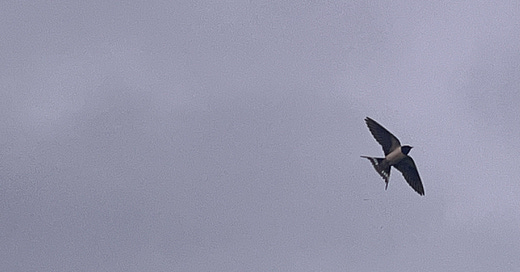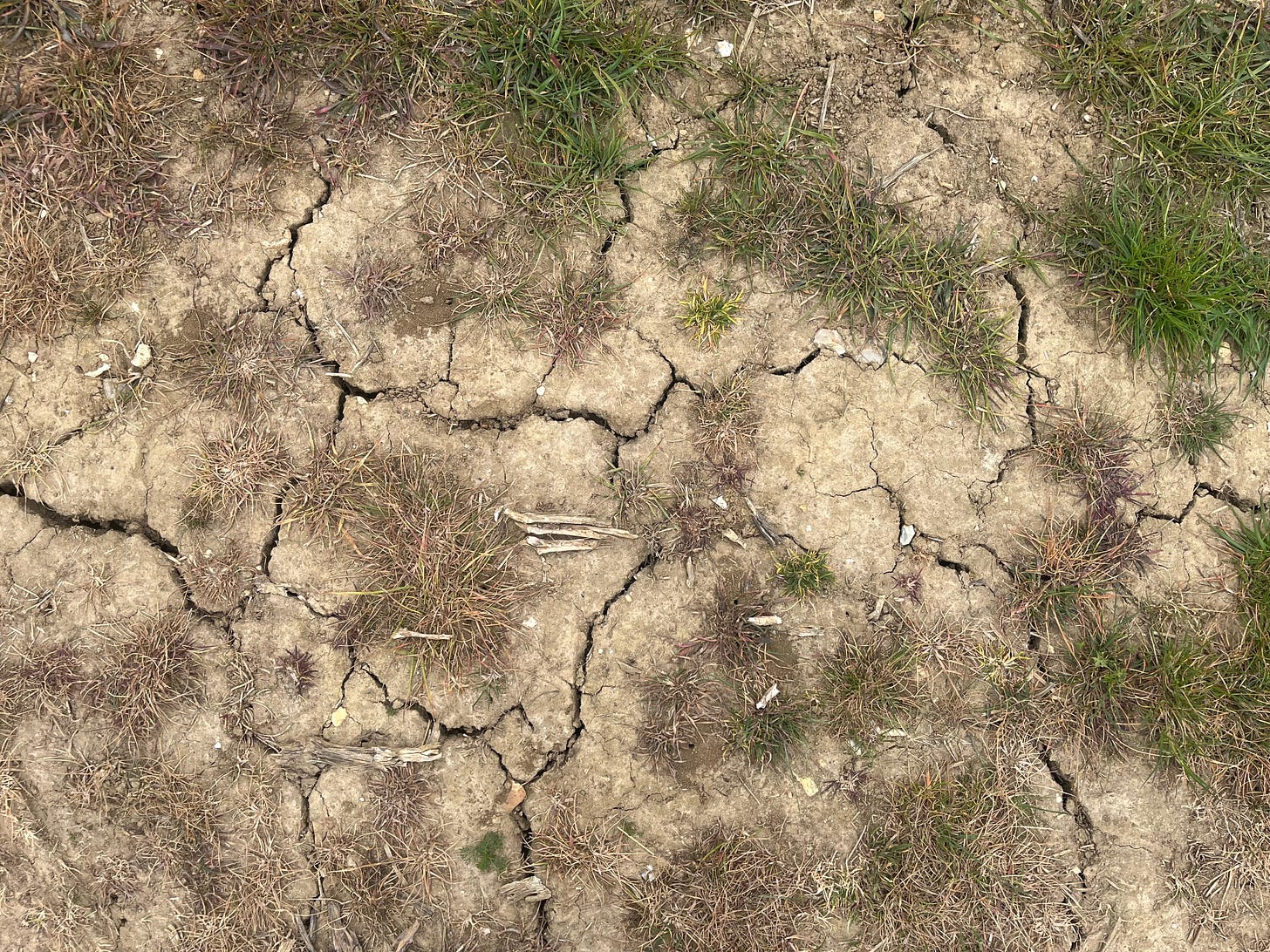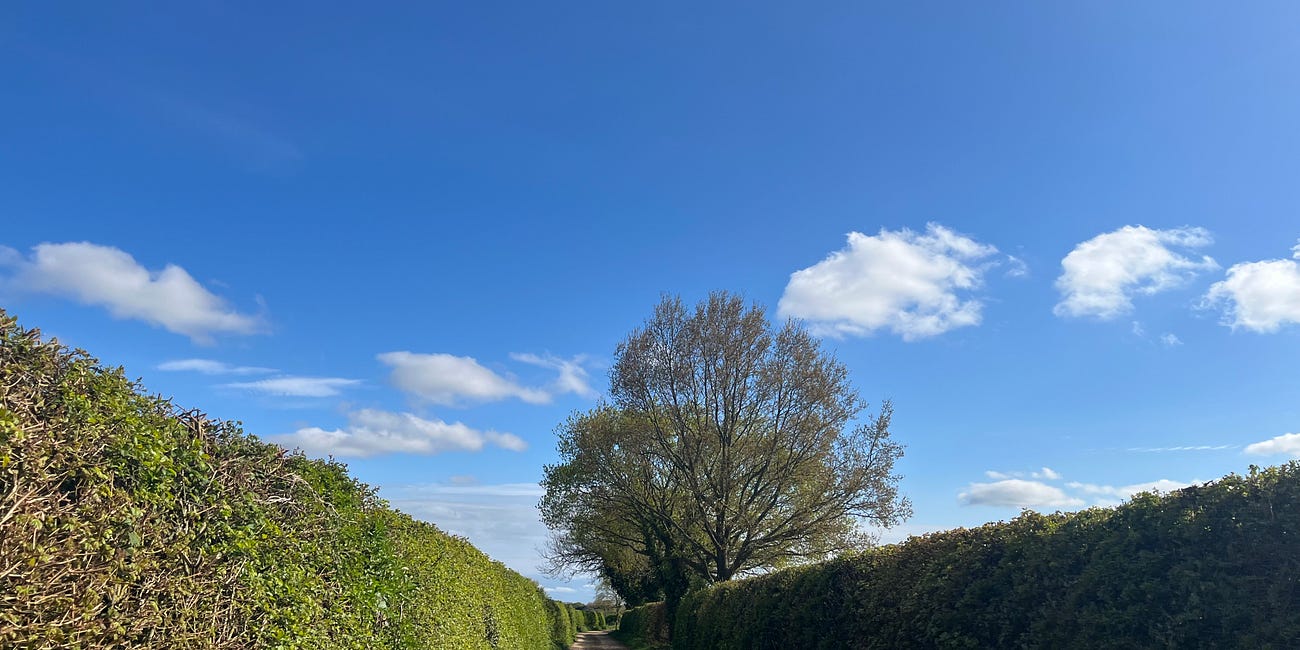Many thanks to those of you who have upgraded your subscriptions to support my writing on here. Thanks are also due to those Substackers recommending this page: History, Landscape, Birds, and Stories; Hinterland; All My Old Haunts; The Guild of Master Procrastinators; Another Disappointing Walk, and Some Flowers Soon.
If you don’t wish to upgrade but would like to throw some financial appreciation in my direction then I also have a tip jar using Stripe.
25/4
Swallows! A pair of them go zinging over one of the parish’s overgrown orchards. It is the early evening and we are returning from our walk. They flash past, low and jinking back and forth in search of insects. The gnats are more noticeable now, forming clouds around us in the lanes. The verges are full of flowers now, though it’s noticeable how it is a mix of native wildflowers and exotic garden escapees, like the Spanish bluebell. The cowslips seem to be at their peak right now with great clumps of them in the field edges.
26/4
Our youngest needs to be dropped early for a practice Duke of Edinburgh walk, so we take the opportunity to drive up through the backroads and villages to Holt, where we dodge volunteers for Reform UK giving out leaflets and find a place to have coffee. The countryside between Holt and Norwich, if you meander off the main routes, is a maze of single tracked lanes flanked by dense hedges and verges full of cow parsley. Each village seems to be a perfect representation of time-slipped rurality, though I’m guessing that there will be a fair share of second homes, closed pubs, and abandoned village shops. We stop at a farm we used to purchase from in farmer’s markets, years ago, and stock up on a chicken and some sausages, leaving cash in their honesty box.
27/4
It is warm enough to eat outside, though it is a Sunday marked by teaching preparation, and so lunch is about the limit of my outdoor activity.
30/4
I take my MA Creative Writing students for an excursion into the wilds of UEA campus. We are spending a week on nature and place writing and moving beyond the four walls of our seminar room in Earlham Hall feels appropriate to the task in hand. It is also a glorious day, the temperature in the high twenties. We read some Kathleen Jamie beforehand. ‘It is a late spring day in the early Anthropocene,’ she writes, or words to that effect, in ‘Reindeer cave’. I feel the weight of those words as we step into the unseasonal heat. The grass of Earlham park is already looking dusty. There are groups of bluebells growing in the shade and shelter of the old trees, great old pollards and field oaks that are finally heaving into leaf like grand ships releasing their sails.
I had intended to scout for a location, but instead I trust in my nose and my memory. The River Yare runs through the campus, filling the famous Broad, wetting its woods and pastures, which are managed carefully for wildlife. We used to come here often as a family when our daughters were younger and we lived within close walking distance. It was, for a long time, the closest access to nature that we had. I remember that beyond the strip of woodland known as ‘the heronry’ there is a field next to the river. I lead my students into the wood and follow my nose up the path that I think will lead to it. Two walkers come in the other direction; they are lost and ask the way to the nearby Rugby fields. Today is Derby Day on campus, and the sports fields, courts, and main square are bustling with competitors and supporters, with noise and energy.
Sure enough the path leads to a kissing gate which leads to the field. I know at once that this is the right place to come to. The field is rough pasture, grazed by a few brown and white cattle that rest in the shade of the riverside willows. The field is edged by the Yare on one side and the woodland edge on the other. Despite the roar of the Rugby supporters it is peaceful here. I have three writing tasks, two broadly observational, with the final task moving towards the speculative. My responses to the first two tasks are typed up below.
1.
The air is full of seed, fluff carried on the soft breeze from the bulrushes in the reed beds. This is rough wet pasture, bat habitat, though right now they’ll be under bark. It is late spring and the land is bursting with green. Behind me a chiffchaff with a single-minded refrain. A wren in full melody. The flash of a magpie in the wood, moving between the branches of willow and oak. Bugs all business around my head. A mosquito drones past, dragging its undercarriage in a leggy triangle beneath it. Further off, music and mayhem. The cheers and claps of the rugby pitches. The shush of the A47. The side of a van shifting in and out of sight on the Watton Road. The contrails of jets kilometres overhead, people speeding in air conditioned pressurized isolation to holiday and business destinations. A woodpecker drums, oblivious to the human world—an oblivion I can only envy.
2.
Along the woodland edge, the grooved bark of willows - too dark to be a pure brown, at this distance the shadows are black and the sun makes the ridges almost white. Their leaves are pale green, almost mint green. Their trunks and limbs arching and leaning, never straight. These are not trees for timber. The first leaves of the oak are a vibrant green, as if a green were trying to be yellow. They seem touched with gold and sun. Hawthorn is foaming with blossom. It is May tomorrow. Hawthorn time. A fence marks the transition from wood to field, to stop the cows from seeking the shade of the trees perhaps, to keep the deer from the understory. Between me and the woodland edge a stretch of rough grass, sedge I think. Last year’s growth is dry and sun-bleached. The fresh growth forming thick blades that look like they could cut. A tangle of brambles conceals the decaying remains of a fallen tree, the old wood chewed up by insects and decay. A young sapling, a hazel, rises from the edge of it.
After each task we read out from our notebooks. It is striking, how in each instance, the same environs are rendered differently, made Other through another’s gaze. How each student focuses on different details or scenes, or finds ways of using the descriptions to articulate environmental concerns or other preoccupations. I’m unable to write the third task, as I become preoccupied trying to work out from my phone, which has limited reception, where my next room-bound meeting is following the workshop. An outdoor writing task like this feels transgressive of the normal rules, and strangely familiar, a reminder of those hot summer days of my childhood when our primary school teachers would move learning out of doors onto the playing fields, because back then it would possible to teach and learn without constant regress to a screen. I feel more relaxed than I have all day.
1/5
After shutting up the hens after sunset I turn my headtorch to its red light setting and watch for rats. I can hear the drone of a motorbike cycling through its gears on the road to the nearest market town. I try to listen for rodents. There is a kerfuffle from the hen house, but it is only the hens jostling into their perches. In the end I give up. The rats must be in the copse or the field beyond. I’m not sure what I’m even hoping to achieve by waiting for them as I have nothing with which to catch or kill them. The dusk is already advanced and the first stars are beginning to prick through the heavy grey of the sky. I hope to see bats. It is a muggy evening, an evening for bats, and I wait longer in the dark, a pool of red light around me. I can hear one of my daughters singing along to music on her Bluetooth speaker as she showers. I wait, but there is nothing in the sky, no movement, and I wonder if I’m impatient for something to happen, for some signal to occur. I guess that sometimes you just have to accept that no signal will come, that the wild will remain hidden from view.
3/5
The wind is casting down the blossom from the cherry and apple trees. The hedges along the top fields are frothing with hawthorn blossom, replacing the blackthorn of a month ago. The field maples are filling out their leaves and pushing forth new growth. In the corner of one of the fields we hear a sedge warbler, though it is the Merlin app that confirms this for me. The sedge warbler is a summer visitor. It is giving an alarm call from somewhere inside a thicket of brambles, and I’m guessing this is where it has its nest. The ground is parched, cracked in places along the track.
The cow parsley is starting to form stronger heads of white along the verges. The wind blusters around us. It is mid-afternoon, but not a single car passes us on the lanes. Norwich FC is playing, and I’m guessing many people are watching this at home. As we come back into the village past the fields of the livery yard the sky is suddenly full of swallows. They dive and swoop, bank and jink. The art of flight is to do with the careful management of energy, of turning the kinetic energy of the dive back into a climb, or realising the potential energy of gravity to do the work. The swallows show their mastery of this principle over and over, streaking past us at just above head height. They are feeding on the insects over the paddocks. I can’t imagine how they begin to accurately locate and track the movement of their tiny prey at such speeds. There must be a dozen or more on the wing. They are too fast to count. As we walk on we see a gathering of them on the electricity cables a couple of fields away. Birds peel off or join the gathering in singly or in small groups, but there must now be, we realise, far more than a dozen in total either roosting or wheeling overhead.
About ‘This Party’s Over’
On ‘This Party’s Over’ I publish my creative non-fiction, personal essays, place writing, and a country diary. My ‘Another Country Diary’ pieces are my most regular posts (about three a month).
The country diary can express a sort of local distinctiveness, explore a personal set of interactions with a landscape, and in doing so, almost accidentally, tease out the way the natural world is entwined with culture and politics. It can be a quietly radical and uncanny form, or sometimes just plain parochial, oddball in its specificity.
If you enjoyed this post, then follow the link to the last one to read more, and, if you are feeling in the mood to, like, share, and subscribe for free.
Another Country Diary #23
This Party's Over is a reader-supported publication. To receive new posts and support my work, consider becoming a free or paid subscriber.







Oh, lovely...but is it time to start wishing you rain? That photo of cracked earth has me concerned.
I enjoyed reading this so much and it was so beautifully written too
A wonderful read on a quiet Sunday morning